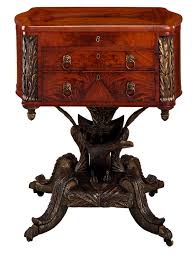Ancient Roman Décor: Tables were designed uniquely and were either made of wood or stone and sometimes embellished with precious metal. Round tables made from the African cedar were considered the most expensive. The one-legged monopodium was used to hold a single lamp or toiletries.
The rectangular abacus held dishes and often used as a sideboard, while a three-legged, bronze or marble table was called mensa Delphica. Most tables had adjustable legs and a concrete one was often built for use in the dining room.

Wooden and iron-bound chests were common in every home and came in different sizes. The smaller ones, which were either made of gold or silver, were used to keep jewels. Cabinets were also made of the same materials and had intricate designs as well.
Ancient Roman Décor of Tables Chests Furniture
Completely without locks or hinges, these cabinets held compartments but had no sliding drawers. Some were kept in the library to hold books while others were kept in the alae to contain the max masks of Roman ancestors.
Other popular house decorations or common household tools were the water clock clepsydra, which was used to mark the night and day hours and could be kept indoors, and the ornate lamps which contained olive oil or melted fat with twisted threads as wicks.

In large public areas, tall stands called candelabrum were used to hold these lamps but since Romans were not natural candle-makers, these were not often used. Lastly, the brazier coals were used for burning coals and could also be found in most homes in ancient Rome.
Table Décor and Centerpieces
The table décor and centerpieces were covered in white linens with a decorative cloth over the top gold lame. Large bowls of fruit make perfect centerpieces: apples, pears, grapes, etc.
Another centerpiece idea was also the use of gold-colored birdcages with a pair of the love-birds inside. Tall pottery vases filled with wheat stalks as centerpieces. Rose petals were scattered around the center of the tables.

At the time of weddings, tall columns were created. Ivy has wrapped down the columns and place urns with flowers on top. Garland was draped of ivy or myrtle in front of tables, across doorways, etc.
Large pottery urns and bowls for serving food and drinks were also used. Other items that Romans often used were sundials, bird baths, reflecting pools, marble garden benches, large pillows and comfortable reclining couches.
Colors: Some of the popular colors in the ancient Roman décor were:
White:
The color white was associated with purity, protection, bringing peace and comfort, and helping cleanse inner emotions. White gave a person a feeling of freedom and openness. However, too much white can give the feeling that space was also considered cold and isolated.
Gold:
Gold was a regal color and fitted beautifully with the ancient Roman theme. It was associated with the sun, abundance, power, wisdom, and understanding. Also, it was mentally revitalizing, inspiring, and helps keep the mind from losing interest.
Purple:
Purple symbolized royalty, power, luxury, sophistication, wealth, spirituality, dignity, nobility, and enlightenment. It was also romantic and helped a person to improve his image.
Other ideas include decorating arches, columns, the fence, and trellis with vine leaves. You can also spray paint columns in gold and then dress them up with greenery by wrapping vines in a spiral pattern around the columns.
Lighting:
Lighting was also an essential element in the ancient Roman décor. These were done by:
Candles:
Candles were the perfect touch for a table and other areas that could use subdued lighting. Not only did candles provide subtle lighting, but it also added a dash of romance and mysticism to the party.
Lanterns:
Lanterns were another fabulous source of lighting. They were available in a variety of styles and one could also find them made of metal with colored glass panels. The bronze metal color gave it somewhat of an aged look, which fits perfectly with the ancient Roman style.
More info on- Roman Apartment Decor



